Grilled Prime Rib is an amazing show stopping roast perfect for a holiday or special occasion. This Prime Rib is grilled at a consistent temperature throughout, and then topped with a homemade Herb Compound Butter. This is truly one amazing holiday roast recipe that is easy to perfect.
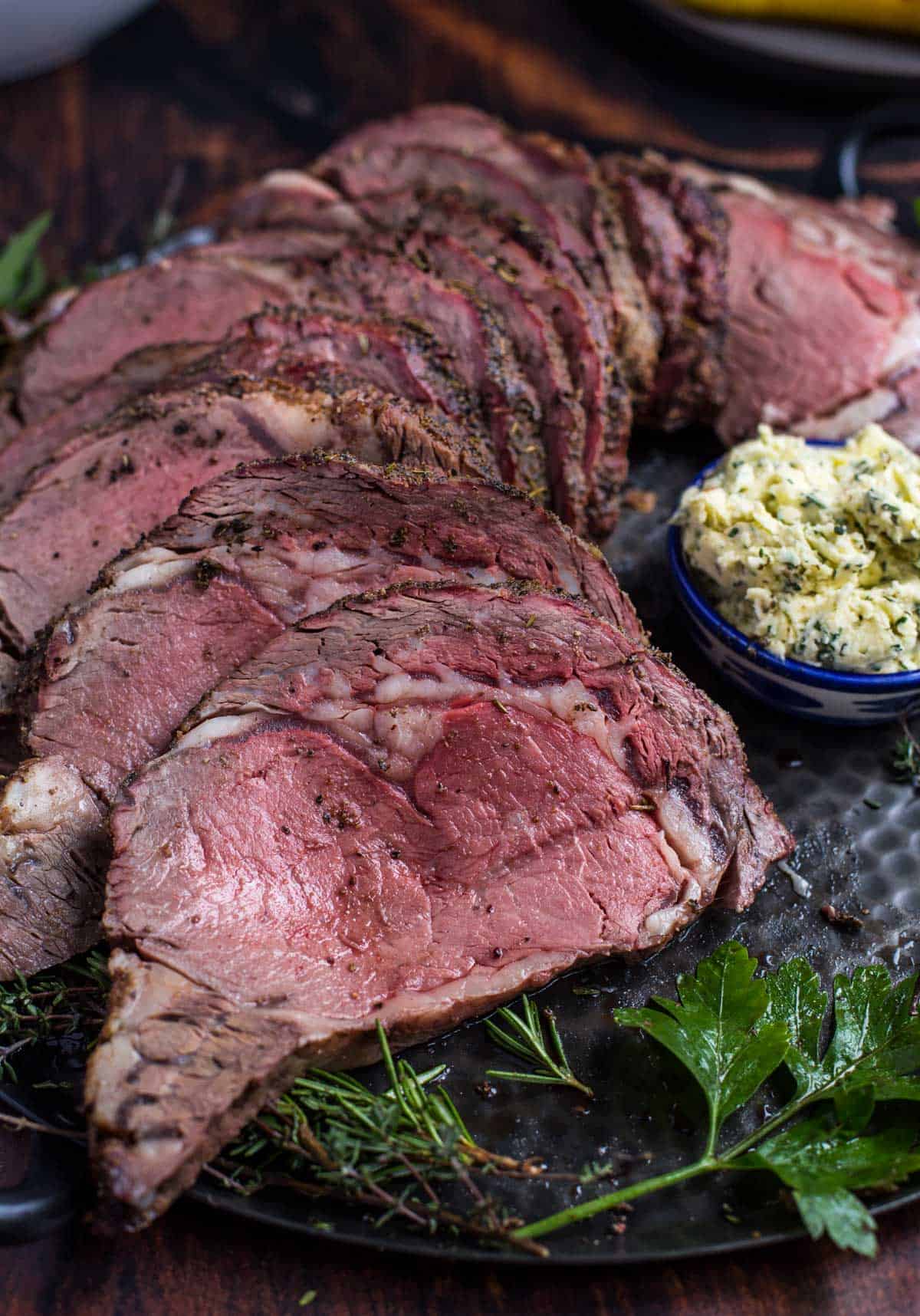
This recipe and article are sponsored by Beef. It’s What’s For Dinner on behalf of the Beef Checkoff. All opinions are our own.
[feast_advanced_jump_to]
The Cut – What is Prime Rib
Prime Rib received its name not because of the quality rating of the cut, but because it comes from one of the primal, or first cuts, of the beef as it’s butchered into smaller roasts and steaks. The meat is tender and very well marbled as it’s situated under the front of the backbone and is a support muscle. This means a tender flavor that does well roasted or grilled versus a cut that needs braising because it’s tougher, like Brisket.
You will also see a Prime Rib labeled as:
- Ribeye Roast
- Standing Rib Roast
- Rib Roast
Sourcing
Choosing a Rib Roast can be intimidating, so we’re highlighting a few things to think about before you head out to the store or look for one online. First of all, just because it says “Prime Rib” does not mean it is actually rated as Prime quality. Look at the packaging details, and if it’s rated it should show a USDA stamp showing Prime, Choice, or Select as the rating and stamped onto the packaging.
Regardless of the rating, buy a Rib Roast that has the most visible marbling (or intramuscular fat). This will render as it roasts and provide more flavor. If you are buying a grass fed only roast, this is even more important (as 100% grass fed beef tends to be much leaner, resulting in less marbling).
The leaner the roast the faster it will cook, reinforcing that you cook to the internal temperature of the meat, not a specific time. Invest in a good instant read thermometer or Bluetooth thermometer when cooking large roasts.
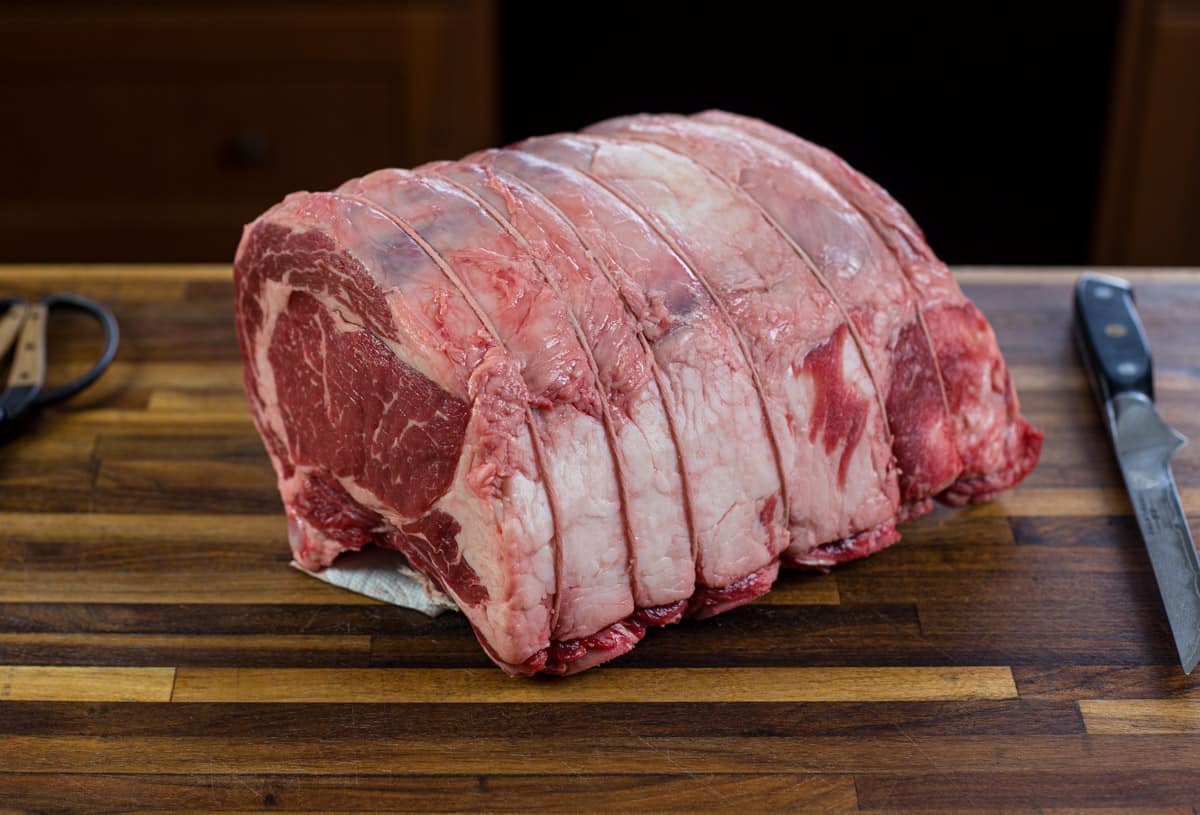
Boneless or Bone-In
You will usually have an option to buy boneless or bone-in. For grilled Prime Rib we recommend you buy bone-in. The bone is going to act as a layer that will protect the valuable and expensive prime rib roast from the heat as it grills.
We strongly recommend grilling with a bone-in roast. If you cannot find a bone-in standing Rib Roast, then you can follow the same directions with a boneless roast, except halfway through the grilling process you need to flip the roast in order to cook it evenly because it does not have the bone shield protecting the bottom of the rib roast.
Butcher’s Note: It’s common when buying a Prime Rib Roast to see the bones already cut away from the roast and tied back together with the roast, or trussed. This is to make it easier to cut the roast when it’s done cooking. You don’t have to buy it this way, if the bone is still attached it is easier to cut them away before grilling. (See video for more details on this note)
Prime Rib Seasoning
When cooking Beef, we prefer the natural Beef flavor to come out first, followed by the seasoning. Our Prime Rib Seasoning is a simple combination of kosher salt, coarse black pepper, granulated garlic, dried rosemary, dried thyme, and dried sage. This savory and herbal mix really shines. Simply mix all the dry ingredients together in a bowl and then apply liberally to the roast.
See the recipe for the details. Plan 1/2 cup of rub for every 4 pounds of roast.
Chef’s Note: Avoid sugar in your seasoning for grilled Prime Rib because it will scorch and burn giving a bitter flavor.
If you want something even simpler, go with our basic beef seasoning of equal parts kosher salt, coarse black pepper, and granulated garlic.
Preparation for Grilled Prime Rib
- Remove the twine if the bones have been tied back to the roast.
- Trim away excess fat and silver skin. If you purchased a well-marbled rib roast, then you will have plenty of flavor inside of the roast. Avoid losing the underlying shape of the roast. So cut away in small increments.
- Coat the roast in olive oil to help the prime rib seasoning adhere to the meat.
- Liberally season all sides of the meat with the Prime Rib Seasoning
- Tie the bones back onto the roast using kitchen twine.
Herbed Compound Butter
A compound butter is a combination of butter and seasoning or fresh herbs to add flavor to a dish. For grilled Prime Rib we’re adding fresh herbs to unsalted butter.
Finely chop fresh rosemary, parsley, and thyme and add to room temperature or softened unsalted butter. Then add kosher salt, mix together, and combine. You can roll up the butter in a log and harden in the refrigerator or simply spoon the butter from the dish over the slices after you plate the food.
This can be made up to three days in advance.
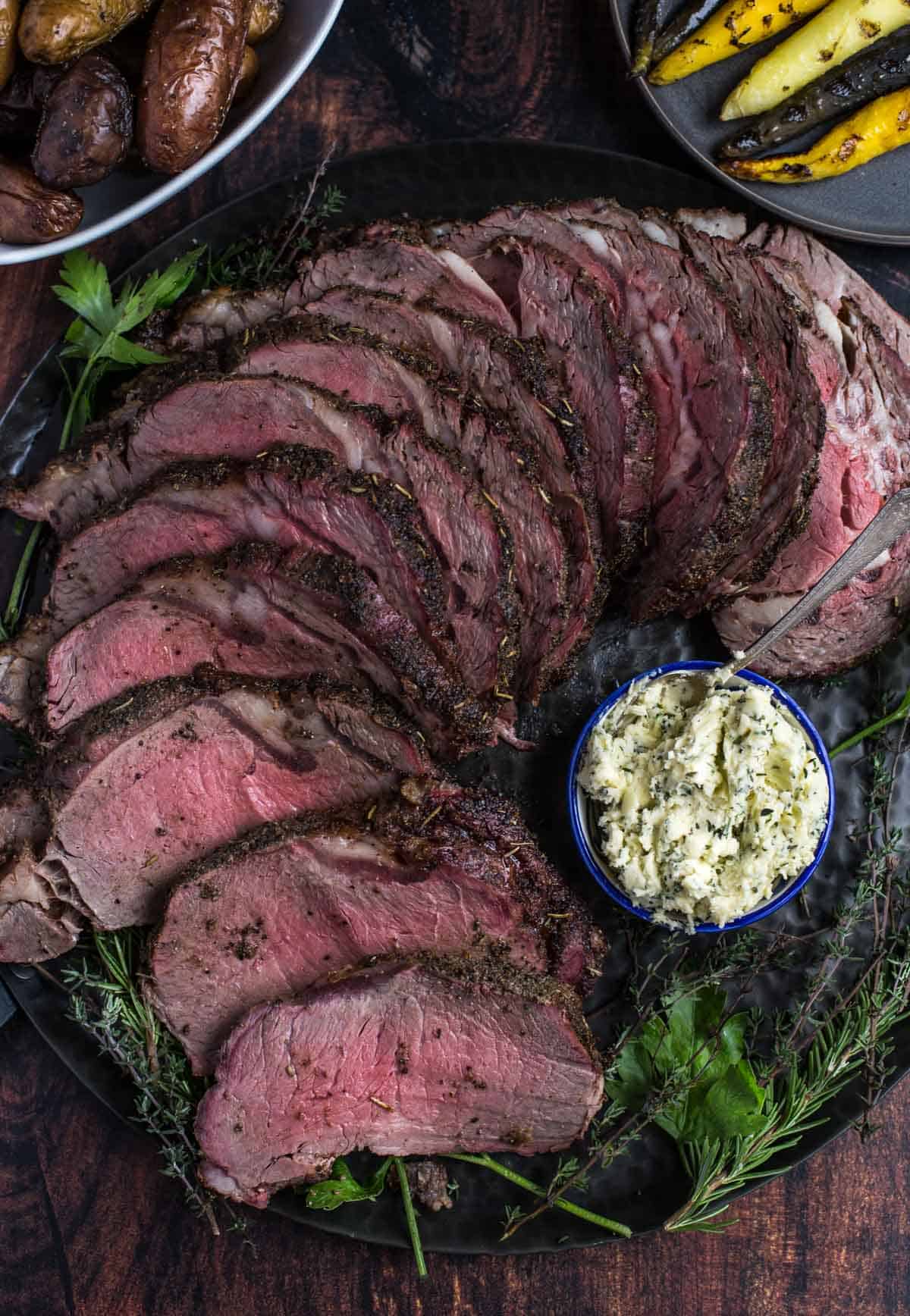
Grill Set Up
Regardless of the type of grill, it is best to grill the Prime Rib using indirect, or two-zone grilling. This prevents a direct heat source from burning the outer edge while undercooking the interior of the meat. For each cooker target an internal cooking temperature of 275 degrees Fahrenheit (F).
On A Big Green Egg or Kamado Grill
Set up your grill using your plate, or ConvEGGTor, with the grate on top of the plate. This creates indirect cooking by directing the heat around the plate. Place the roast in the center of the grate.
On a Pellet Grill
Pellet grills have a heat shield that automatically defaults to an indirect cooker. Set the startup and target temperature to 375 degrees F and then place the roast in the center of the cooker.
On a Kettle Grill
Place the ignited charcoal on one side of the grill. Place the grate on top and grill the Prime Rib on the indirect side. Unlike the other grills, the heat source for a kettle grill will be closer to the actual roast. So, modify the grill directions by turning the roast every 30 minutes so that each side of the grill faces the heat source for the same amount of time. This creates and even cook.
Or you can place the roast with the bone facing the heat, but it’s easier to just rotate. You can read more on how to start a charcoal fire in our guide.
On a Gas Grill
Most gas grills have at least three burners. Ignite the two outer burners and set to medium. Adjust the heat up or down to achieve 375 degrees. Place the roast in the center over the burner that is not ignited and follow the recipe instructions until done.
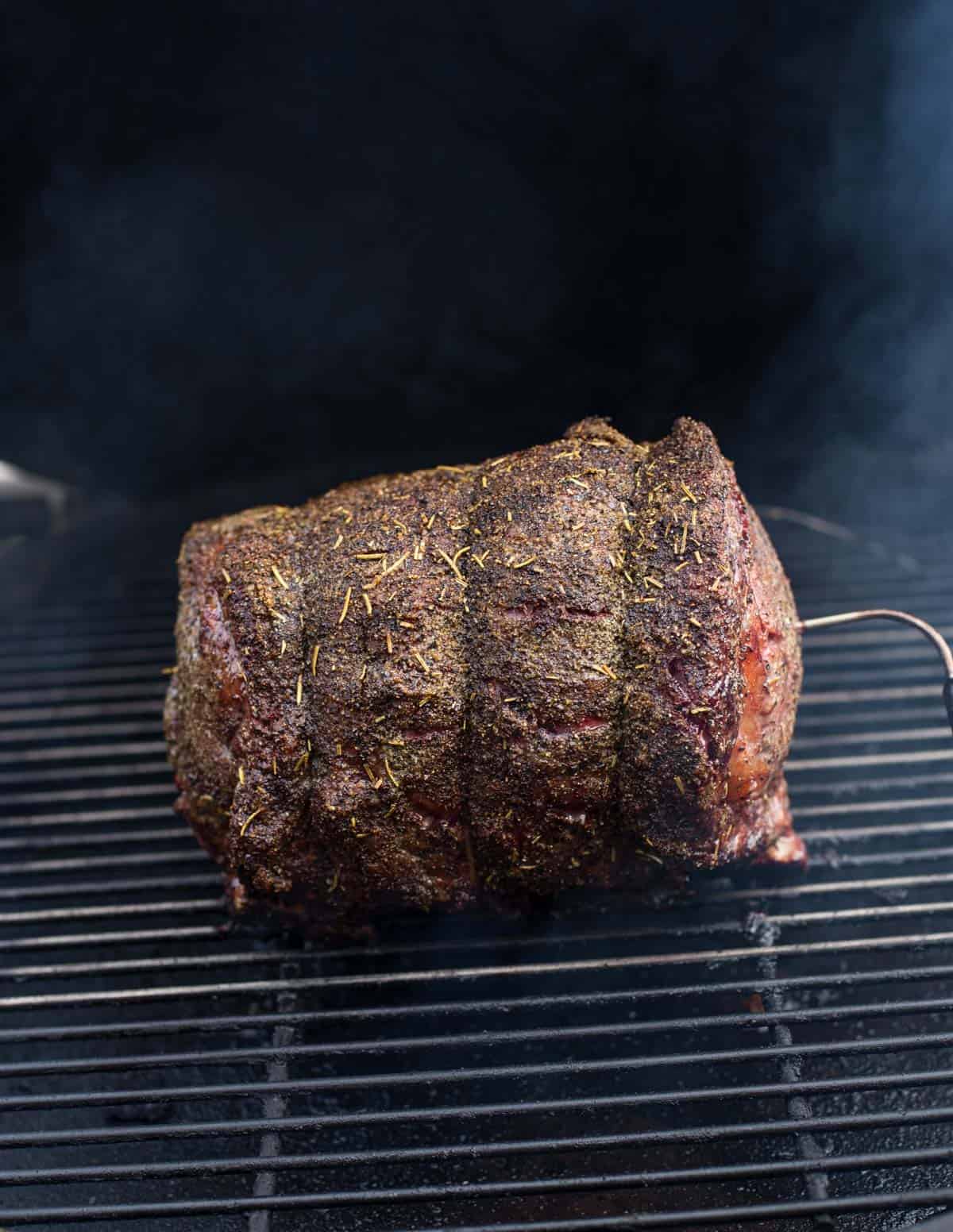
How to Grill Prime Rib
- Prepare grill for indirect (or two-zone) grilling with the target temperature of the grill at 375 degrees F.
- Place the seasoned roast on the grill over indirect heat. Insert a good digital Bluetooth thermometer so the probe is in the center of the roast.
- Close the lid and grill covered until the internal temperature of the roast is at 120 degrees F.
- When it hits 120 degrees, remove the thermometer probe and place the roast on a cutting board and let rest loosely tented in foil for 30 minutes.
- After 30 minutes, discard the foil, cut away the twine and separate the rib bones. Slice the roast and then serve with a dollop of the herb butter.
Chef’s Tip: The remote probe is a good checking point for one portion of the roast. But using a second instant read thermometer is also important so you can check a few places to be sure the roast is cooked to your desired temperature throughout. The outer edges of the roast will always be a higher temperature so check in various areas toward the center of the roast.
Resting and Carry Over Cooking
Carry over cooking occurs as the Prime Rib continues to cook even after you remove from the heat source (grill). For a large roast this will be around 10 additional degrees. Take into consideration the additional 10 degrees when removing the roast from the grill.
The USDA recommends cooking a Rib Roast to 145 degrees F. To best achieve this, remove the roast from the grill when the internal temperature at the center of the roast is 130. Let rest loosely tented in foil to allow carry over cooking to occur, allowing it to achieve a temperature of 145 degrees F
However if you like your rib roast on the rare side, like we do, apply the same concept by removing the roast when the internal temperature reaches 120 degrees F. Then let rest for 30 minutes for carry over cooking and then slice. The roast finishing temperature will be between 130 and 135 degrees F.
We do not recommend cooking a Prime Rib to well done. To accommodate those who like their Beef cooked to a higher temperature, serve the outer edges of the roast because they will always be cooked to the highest internal temperature.
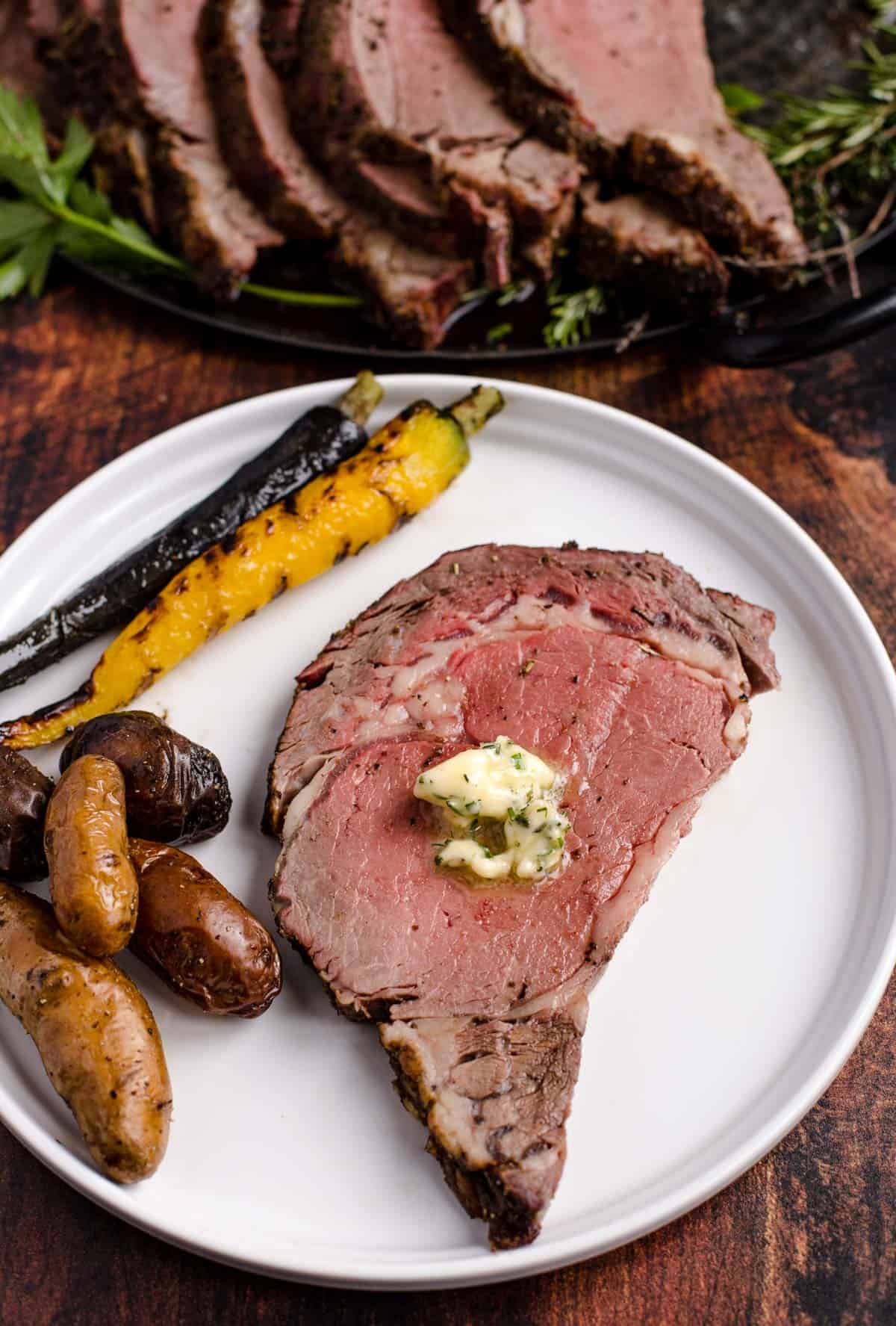
Prime Rib Frequently Asked Questions
Plan 1 pound of roast per person. Or, if ordering by number of bones, plan 1 bone for every 2 people. As the roast cooks it will lose some moisture and weight. So, it’s best to plan for that when buying the Prime Rib.
No, prime references the primal cut versus the grading. Check the labeling on your roast to see if there is a grade. Otherwise look for marbling within the roast. The more marbling the more flavor.
Plan 12 – 15 minutes per pound and 30 minutes of rest time. Always cook to internal temperature and not time using a reliable instant read or Bluetooth thermometer.
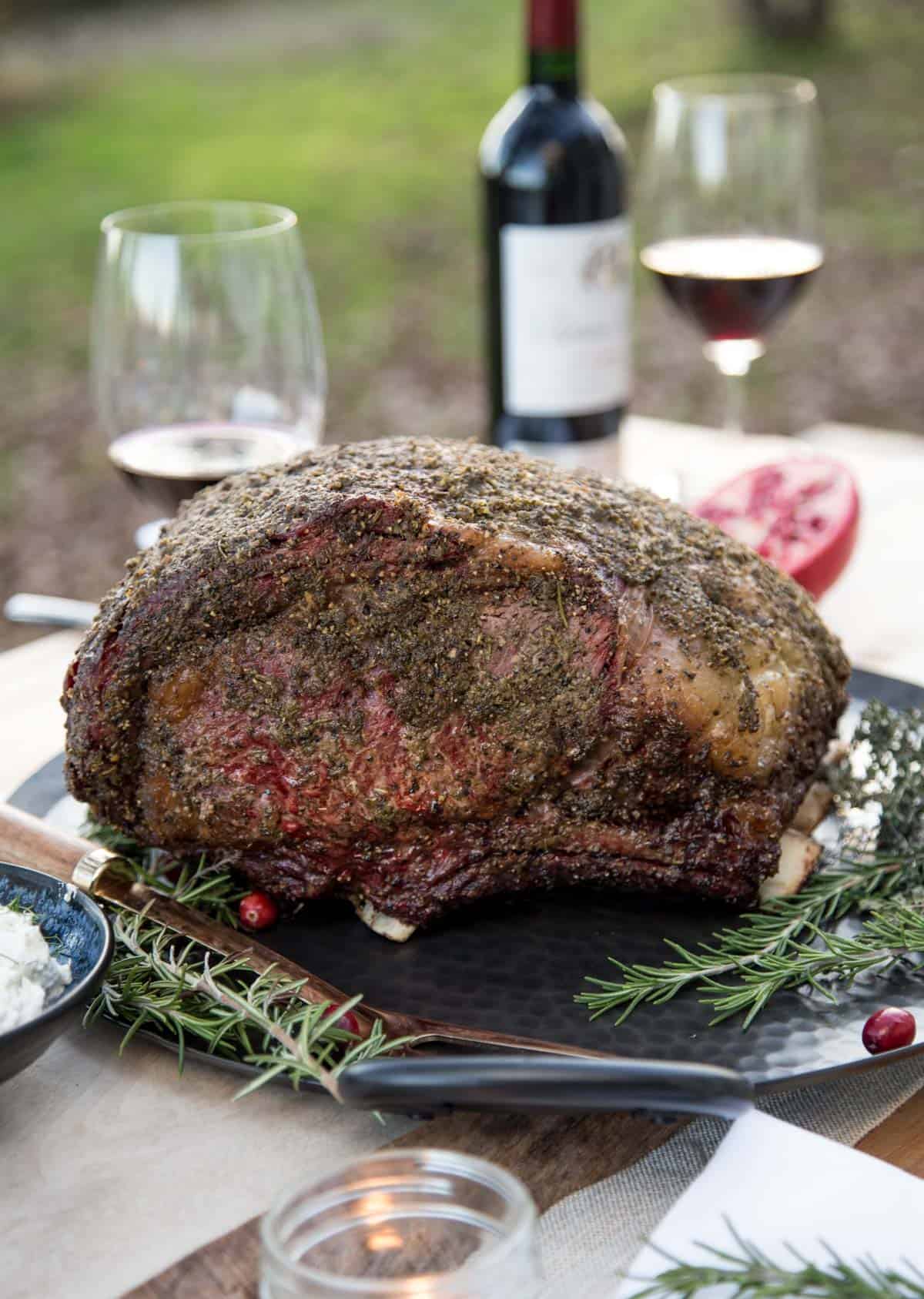
Other Beef Roast Recipe Ideas
You can read our article about pairing wines with your Beef Holiday Roasts, and check out our other delicious Beef Roast recipes.
- Reverse Seared Beef Tenderloin
- Smoked Prime Rib Recipe with Herb Crust
- Reverse Seared Prime Rib with Horseradish Butter
- Smoked Beef Chuck Roast Stew
Side Dishes for Grilled Prime Rib
- Duck Fat Roasted Potatoes
- Grilled Broccolini
- Caesar Salad with Grilled Romaine
- Grilled Sweet Potatoes
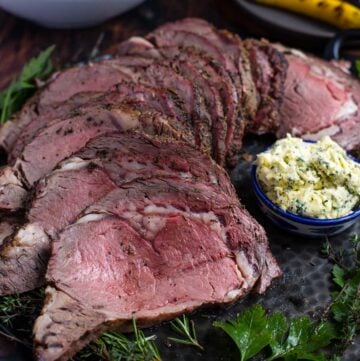
Grilled Prime Rib Recipe with Herb Compound Butter
#wprm-recipe-user-rating-0 .wprm-rating-star.wprm-rating-star-full svg * { fill: #ffffff; }#wprm-recipe-user-rating-0 .wprm-rating-star.wprm-rating-star-33 svg * { fill: url(#wprm-recipe-user-rating-0-33); }#wprm-recipe-user-rating-0 .wprm-rating-star.wprm-rating-star-50 svg * { fill: url(#wprm-recipe-user-rating-0-50); }#wprm-recipe-user-rating-0 .wprm-rating-star.wprm-rating-star-66 svg * { fill: url(#wprm-recipe-user-rating-0-66); }linearGradient#wprm-recipe-user-rating-0-33 stop { stop-color: #ffffff; }linearGradient#wprm-recipe-user-rating-0-50 stop { stop-color: #ffffff; }linearGradient#wprm-recipe-user-rating-0-66 stop { stop-color: #ffffff; }
Equipment
-
Boning Knife
-
Butcher Twine
-
Slicer Knife
Ingredients
- 4 bone Prime Rib Roast (or 8-lbs), (with bones separated from roast) See note 1 for preparation
- 3 tablespoons extra virgin olive oil
Prime Rib Seasoning
- ¼ cup kosher salt
- ¼ cup coarse black pepper
- 2 tablespoons granulated garlic
- 1 tablespoon dried rosemary
- 1 teaspoon dried thyme
- 1 teaspoon dried sage
Herb Compound Butter
- ½ pound unsalted butter, at room temperature (1 stick)
- 2 cloves garlic, minced or finely grated
- 1 teaspoon diced fresh parsley
- 1 teaspoon diced fresh thyme
- 1 teaspoon diced fresh rosemary
- ½ teaspoon kosher salt
Instructions
How to Grill Prime Rib
-
Prepare grill for indirect (or two-zone) grilling with the target temperature of the grill at 375 degrees F.
-
Place the seasoned roast on the grill over indirect heat. Insert a good digital Bluetooth thermometer so the probe is in the center of the roast.
-
Close the lid and grill covered until the internal temperature of the roast is at 120 degrees F.
-
When it hits 120 degrees, remove the thermometer probe and place the roast on a cutting board and let rest loosely tented in foil for 30 minutes.
-
After 30 minutes, discard the foil, cut away the twine and separate the rib bones. Slice the roast and then serve with a dollop of the herb butter.
Herb Compound Butter
-
Finely chop fresh rosemary, parsley, and thyme and add to room temperature or softened unsalted butter. Then add kosher salt, mix together, and combine. You can roll up the butter in a log and harden in the refrigerator or simply spoon the butter from the dish over the slices after you plate the food.
Prime Rib Seasoning
-
Combine all seasoning ingredients in a small bowl and stir to combine.
Notes
- Remove the twine if the bones have been tied back to the roast.
- Trim away excess fat and silver skin. If you purchased a well-marbled rib roast, then you will have plenty of flavor inside of the roast. Avoid losing the underlying shape of the roast. So cut away in small increments.
- Coat the roast in olive oil to help the prime rib seasoning adhere to the meat.
- Liberally season all sides of the meat with the Prime Rib Seasoning
- Tie the bones back onto the roast using kitchen twine.
Chef’s Tip: The remote probe is a good checking point for one portion of the roast. But using a second instant read thermometer is also important so you can check a few places to be sure the roast is cooked to your desired temperature throughout. The outer edges of the roast will always be a higher temperature so check in various areas toward the center of the roast.
Resting and Carry Over Cooking: Carry over cooking occurs as the Prime Rib continues to cook even after you remove from the heat source (grill). For a large roast this will be around 10 additional degrees. Take into consideration the additional 10 degrees when removing the roast from the grill.
For rare, remove the roast at 120 so the finished temperature is 130.
For medium rare, remove the roast at 130 so the finished temperature is 140.
We do not recommend cooking a Prime Rib to well done. To accommodate those who like their Beef cooked to a higher temperature, serve the outer edges of the roast because they will always be cooked to the highest internal temperature.
Nutrition
The post Grilled Prime Rib with Herb Compound Butter appeared first on Vindulge.